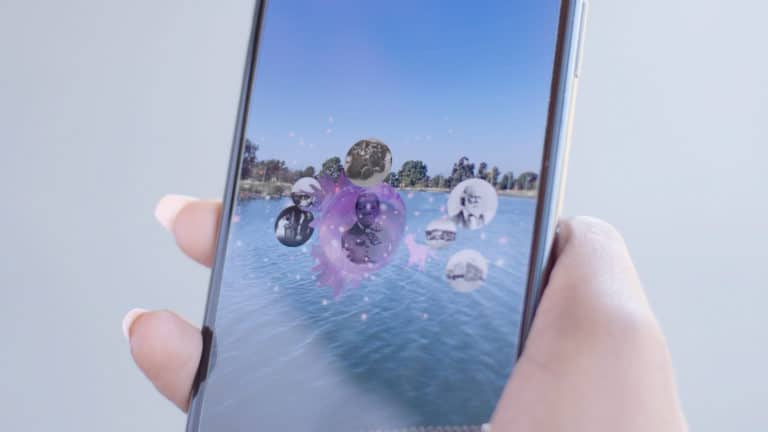
Mobile AR — displayed through your smartphone screen – isn’t AR’s endgame nor its fully-mature self. But it scales today on the backs of more than 3 billion global smartphones. In that way it’s a stepping stone to AR glasses, warming the world up to that eventual reality.
As many AR Insider readers know, mobile AR first entered the public conscience in the summer of 2016 with the debut of Pokémon Go. Users marveled at wild Digletts popping up from their living room floors and wandered the neighborhoods at night, sparking global discussions about location-based technology and AR in general. Now, AR has more use cases… and more controversy. How has it evolved since 2016?
1. Social Media
The rise of Instagram, TikTok, and Snapchat has many people sounding the alarm on face filters. Once relegated to cartoonish, obviously fake overlays — who among us hasn’t seen how they’d look with dog ears? — face filters have become scarily realistic. In 2019, this AR technology made headlines when a longtime vlogger’s filter glitched, exposing her as a much older woman with entirely different facial features.
The story had wider implications than the superficiality of beauty vlogging. When face filters become more like deep fakes than minor enhancements, can you trust your own eyes? Many psychologists have expressed concerns about the effects of face filters on body image — especially when people don’t know their social media feed is full of fakery. Time will tell how this wildly popular use for AR affects society.
2. Education
Few would argue against the use of AR for learning astronomy. Because most night skies worldwide are light-polluted — with the sky getting 9.6% brighter per year on average since 2011 — many children have never seen the Milky Way. Apps like SkyView and Night Sky allow users to hold their phones to the heavens, an AR overlay showing them where the stars should be.
Some textbooks also contain embedded AR markers with supplementary content. Students simply scan the page with their phones to access a video, soundbite, or even 3D rendering of the topic they’re studying. Chemistry AR apps let students visualize molecules in real-time.
Doctors-to-be can use AR to display a model cadaver on the table in front of them, dissecting it or viewing hidden anatomical structures. Professors can even host multi-user AR sessions that allow the entire class to work on the same cadaver. Overall, schools are successfully implementing new tech like AR, creating more opportunities for students to learn.
3. Manufacturing
Augmented reality has revolutionized the manufacturing sector. Agricultural equipment manufacturer AGCO has embraced Google’s industrial AR glasses — Google Glass Enterprise Edition (GGEE) — in its factories. Employees wear GGEE as part of their overall uniform. Instead of juggling a tablet while putting wheels on a tractor, workers can use their voices to snap photos and ask questions about the machinery they’re working on.
And though GGEE was recently discontinued, several other hardware players will fill the void and meet the demand for industrial AR, including Microsoft Hololens 2 and Magic Leap 2.
AR glasses also help workers navigate the factory, alert people to hazards and offer real-time feedback to correct errors. They can provide detailed instructions on the screen and help employees identify the tools and parts required for a task. VR goggles have even found a place in training new workers by immersing them in realistic simulations.
4. Shopping
Virtual dressing rooms let shoppers try on clothes without waiting for a stall to open up. At makeup stores like Sephora and L’Oreal, apps allow customers to see how makeup will look on them without physically having to try it on, sparing the awkwardness of getting a trial makeover and realizing Coral Blue is not your color.
Furniture retailers are also leaning into the AR trend. Ikea and Wayfair let customers view items in their homes before buying them. The apps can’t replace the time-honored tradition of lying on a mattress in the store, but they can take out some of the guesswork.
Although AR has become mainstream, most examples of the technology are for educational or entertainment purposes. That trend will likely change, as more consumers shop online than ever before.
AR Is More Widespread Than Ever
These are just a few examples of how AR is shaping the world. Augmented reality is radically changing almost every industry and it shouldn’t be long before it’s a part of everyday life. In fact, it already is for many people — they just don’t realize it.
 April Miller is a senior writer at ReHack Magazine and editorial contributor at AR Insider. She specializes in VR/AR, IoT, and business technology. See her work here and follow her @rehackmagazine.
April Miller is a senior writer at ReHack Magazine and editorial contributor at AR Insider. She specializes in VR/AR, IoT, and business technology. See her work here and follow her @rehackmagazine.

